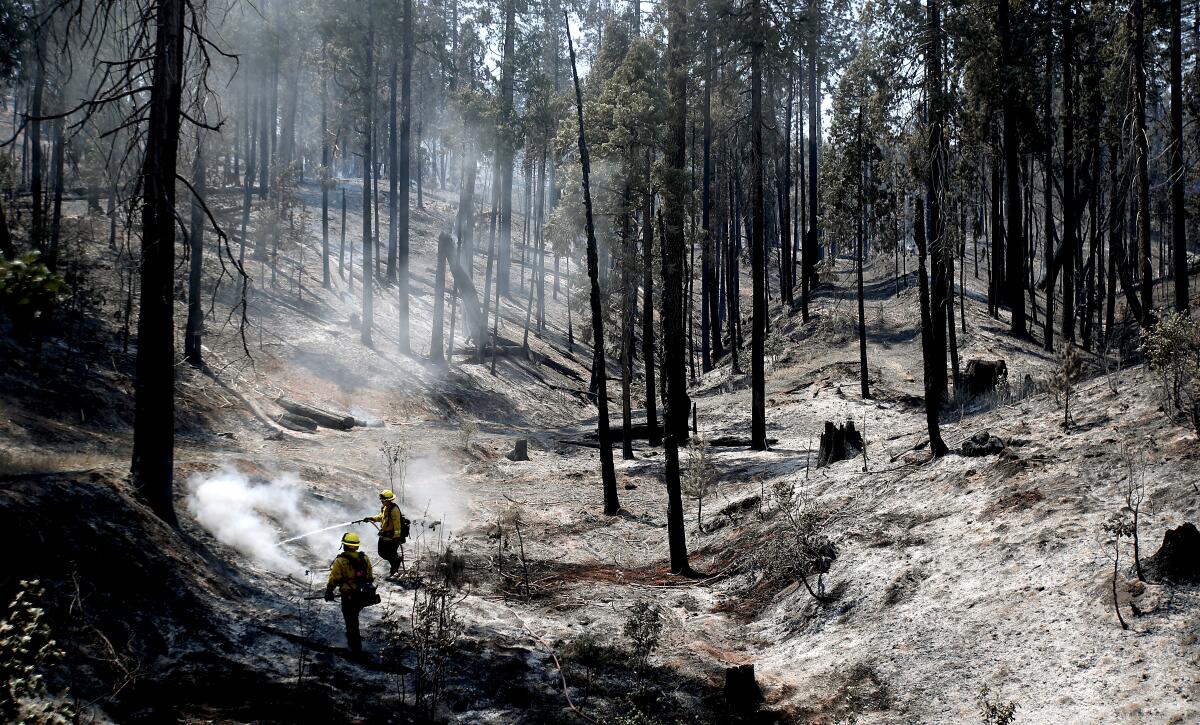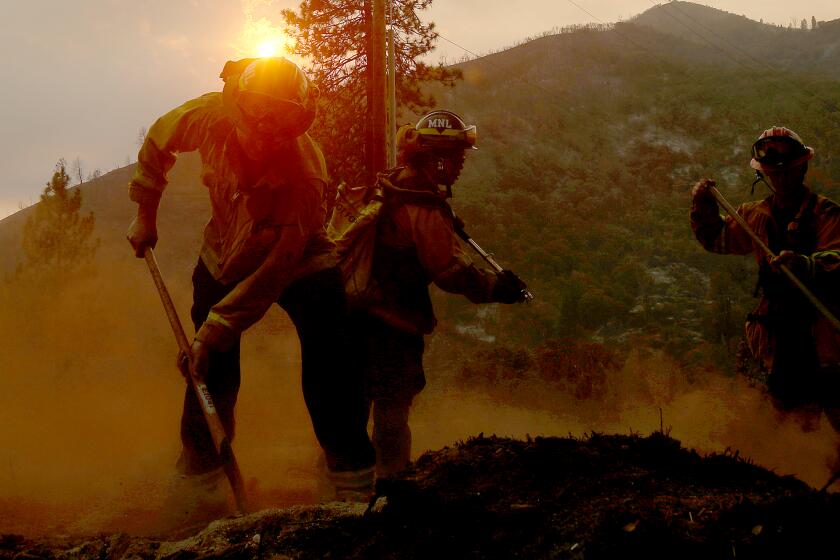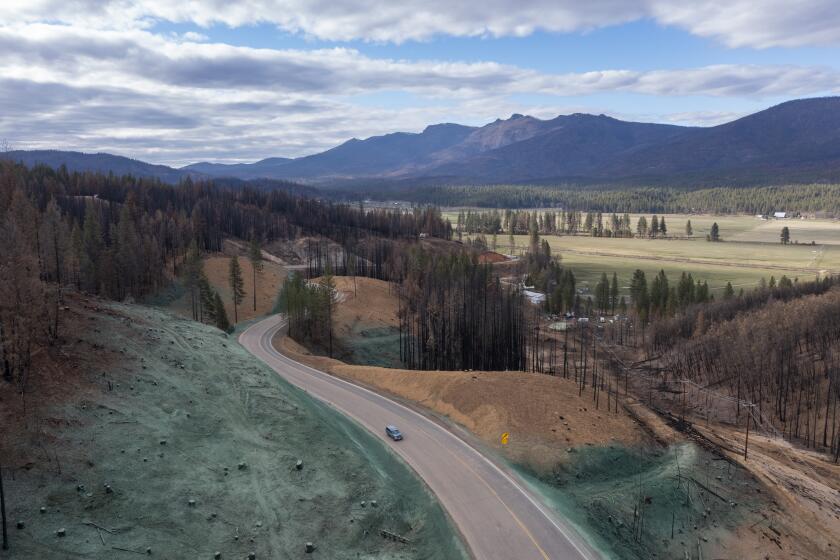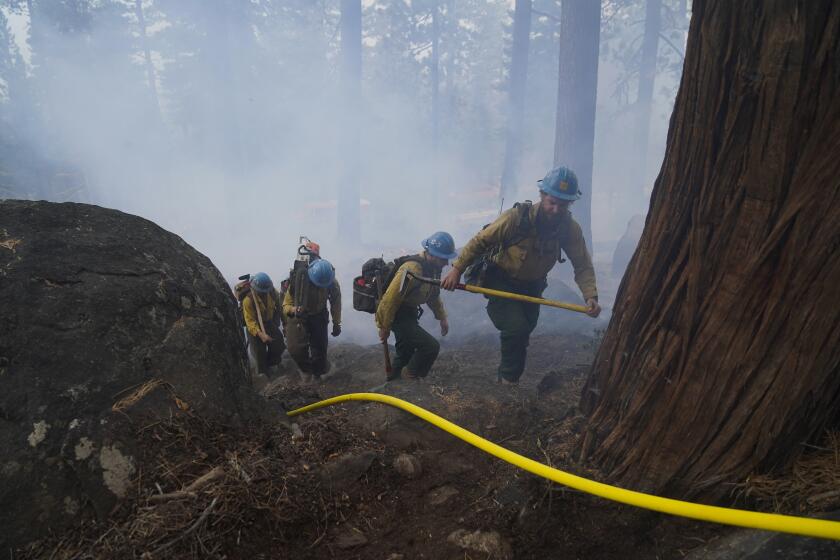Discovering they lost everything in Oak fire: ‘I cried behind a tree for 10 minutes’

- Share via
MARIPOSA, Calif. — Maybe it was shock or maybe it was denial, but when Rodney McGuire learned his home of 22 years had been destroyed in the Oak fire, he held his composure and wondered what he would do next. Then without warning, he stepped behind a tree and burst into tears.
“I put my heart and soul into that house,” the 57-year-old mechanic said. “I cried behind a tree for 10 minutes until I could pull myself together.”
On Wednesday, residents throughout this tiny Sierra Nevada foothill community were learning whether they too had lost their homes in an explosive fire that was still burning in the direction of Yosemite National Park and threatened to enter steep, difficult terrain that was thick with fuel.
But even as fire crews battled flames near the ominously named Devil’s Gulch, authorities began lifting evacuation orders along the blaze’s southern and western flanks. For many evacuees, it was their first opportunity to return home since fleeing beneath a monstrous fire cloud days earlier.
McGuire still hasn’t had a chance to see what’s left of his home, but a video confirmed that his was one of 25 destroyed in the fire — and one of multiple residences that were razed along Triangle Road. When he first spotted smoke emanating from a ridge above his home Friday, all he had time to do was grab his dog and important paperwork. Everything else, he said, is probably gone.
As fire crews made progress in containing the massive Oak fire Tuesday, the arrival of a uniformed militia has sparked concern among some.
So far, the Oak fire has scorched 18,715 acres and destroyed more than 74 structures in five days. Firefighters have made significant gains, however, and reported 32% containment by Wednesday morning. Although the pace of the fire has slowed, it still threatens areas to the north and east, including an area known as Mariposa Pines, which has been surrounded by fire on three sides.
“The fire wants to move into the east, northeast into Devil’s Gulch,” one fire official said during a morning briefing. “All attempts by operations have been very successful, but fuel in here, even though it’s in the Ferguson scar, are continuous.”
Although the area where the 2018 Ferguson fire burned has limited brush growth, it’s enough to give the fire a path to expand.
“If that happens we would expect further growth up to Granite Ridge,” the fire official said.
An increase in catastrophic wildfires has reduced California tree cover by 6.7% since 1985, and researchers fear the lost trees will never grow back.
As crews eyed the fire’s northern and western flanks, officials on Tuesday night reopened Highway 140, which leads into the park and Yosemite Valley.
Since the reopening, Mantreet Kaur has seen the steady trickle of neighbors and regulars driving past her Midpines Store and Gas. Some stop in to pick up supplies and offer an update.
Eventually, those neighbors who have lost homes will stop by with grim news — moments she said she is dreading.
Kaur and her husband stayed behind despite evacuation orders, she said, along with some other residents. The fire was burning less than a mile away, but they decided to take a chance when they saw flames headed the opposite way.
Then the electricity went out.
“It’s been very scary and hard here,” she said. “But we’re lucky.”
Her home, which sits atop the small store, is still standing, and soon business will pick up as residents return.
“But I’m not worried about business right now,” she said.
A federal firefighter’s viral resignation letter is highlighting the job’s low pay and harsh working conditions in the age of climate change.
Meanwhile, firefighters in the southern end worked to knock down hot spots and smoldering areas. The once-scenic two-lane roads flanked by green were now topped in white ash and charred trees. Other stretches of the road were marked with red — remnants of firefighters’ aerial assault.
On Triangle Road, one home appeared to have been leveled by the flames, leaving only a brick chimney standing. At a surviving ranch home nearby, chickens roamed their enclosures awaiting the owner’s return.
At the American Red Cross shelter at Mariposa Elementary School, evacuees swapped stories as the summer heat climbed into the 90s.
“The fire came down the hill so fast,” said Wayne Spencer, a 75-year-old resident whose daughter confirmed the house he lived in on Darrah Road was destroyed.
“It was something to see, wasn’t it?” said another man at the evacuation site.
“I had about five minutes to get the hell out of there.” Spencer replied.
“I had about three,” the other man said.
After moving from the Bay Area nine years ago, Spencer worked as a general contractor and remodeled homes throughout Mariposa County. Along with the two-story home he rented, he lost all of his tools and prized vinyl record collection with albums dating to the 1960s.
Spencer had already been considering moving to Washington to be closer to family there. After losing his rental home, he believes his move has been expedited.
“I already knew I was going, but this was incentive,” he said.
Not everyone is on the same page, however.
McGuire, who moved to the area from Peoria, Ill., never thought he would grow to love the rural life in Mariposa County as much as he has. He’s witnessed several major wildfires since he moved here 22 years ago, including three just this year.
“No place is safe,” he said. “Yosemite is my backyard. This whole town is my family. Why would I want to go anywhere?”
More to Read
Sign up for Essential California
The most important California stories and recommendations in your inbox every morning.
You may occasionally receive promotional content from the Los Angeles Times.














